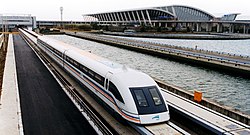Shanghai maglev train
| Shanghai Maglev Train | |
|---|---|
 | |
| Overview | |
| Locale | Shanghai |
| Transit type | MagLev |
| Number of lines | 1 |
| Number of stations | 2 |
| Operation | |
| Began operation | January 1 2004 |
| Operator(s) | Shanghai Maglev Transportation Development Co., Ltd. |
| Technical | |
| System length | 30.5 km (19.0 mi) |



The Shanghai Maglev Train or Shanghai Transrapid (Chinese: 上海磁浮示范运营线; pinyin: Shànghǎi Cífú Shìfàn Yùnyíng Xiàn; lit. 'Shanghai Magnetic Levitation Demonstration Operation Line') is the first commercial high-speed maglev line in the world. The system and trains were built to the Transrapid standard. Construction began in March 2001, and public service commenced on 1 January 2004.
During a test run on 12 November 2003, a maglev vehicle achieved a Chinese record speed of 501 km/h (311 mph).
Background
The line runs from Longyang Road station in Pudong, on the Shanghai subway line 2 to Pudong International Airport. The journey takes 7 minutes and 20 seconds to complete the distance of 30 km. A train can reach 350 km/h (220 mph) in 2 minutes, with the maximum normal operation speed of 431 km/h (268 mph) reached thereafter.
The line is operated by Shanghai Maglev Transportation Development Co., Ltd. As of May 2008[update], the line operates daily between 06:45–21:30, a one-way ticket cost ¥50 (US$7.27), or ¥40 ($5.81) for those passengers holding a receipt or proof of an airline ticket purchase. A round-trip return ticket cost ¥80 ($11.63) and VIP tickets cost double the standard fare.
The service operates once every 15 minutes. It can be easier and faster for those passengers with destinations in west (Puxi) Shanghai to use a taxi directly from Pudong International Airport—although missing out the "thrill factor" of riding on the high-speed Maglev.
Operation
Following the opening, overall maglev train ridership levels were at 20% of capacity,[1] The levels were attributed to limited operating hours, the short length of the line, high ticket prices and the comparatively inconvenient location of the Longyang Road terminus—in Pudong and well away from the centre of Shanghai.[citation needed]
In normal operation, the speed and journey time vary depending upon the time of day.
| Daytime hours | 06:45–08:30 | 08:30–17:00 | 17:00–21:30 |
|---|---|---|---|
| Journey time | 8:10 minutes | 7:20 minutes | 8:10 minutes |
| Maximum speed | 300 km/h (190 mph) | 431 km/h (268 mph) | 300 km/h (190 mph) |
Construction
The Shanghai Transrapid project took ¥10 billion (US$1.33bn) and two and a half years to complete. The line is 30.5 km (19.0 mi) track and has a further separate track leading to a maintenance facility.
Extensions
In January 2006, the Shanghai-Hangzhou Maglev Train extension project was proposed by the Shanghai Urban Planning Administrative Bureau. The extension would continue the existing line towards Shanghai Hongqiao International Airport, running via Shanghai South Railway Station and the Expo 2010 site, with a possibly continuation towards Hangzhou. If built, the extension would allow transferring between the two airports—located 55 km (34 mi) apart—in approximately 15 minutes.
The plan for the extension to Hangzhou was first approved by the central government in February 2006, with a planned date of completion in time for 2010. Work was suspended in 2008, owing to public protests over radiation fears.[2] According to China Daily, as reported on People's Daily Online February 27, 2009, the Shanghai municipal government is considering building the maglev line underground to allay the public's fear of electromagnetic pollution, and the final decision on the maglev line has to be approved by the National Development and Reform commission.
Incidents
On 11 August 2006, a Maglev train compartment caught fire at 2:40 p.m., after having left Pudong International Airport in the direction of Pudong Longyang Road Station. There were no injuries aboard. Preliminary reports indicated that an electrical problem may have been the cause.
